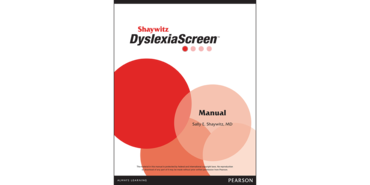Shaywitz DyslexiaScreen™ is an efficient, reliable, and user-friendly dyslexia test for K‐3 students who may be at risk for reading difficulties. NEW Adolescent-Adult Form and Corrections Form information available in Product Details. Guidance on using this test in your telepractice.
Shaywitz DyslexiaScreen
Shaywitz DyslexiaScreen™ is an efficient, reliable, and user-friendly dyslexia test for K‐3 students who may be at risk for reading difficulties. NEW Adolescent-Adult Form and Corrections Form information available in Product Details. Guidance on using this test in your telepractice.Choose from our formats
Test forms reports
Booklets, record forms, answer sheets, report usages & subscriptions
1 option
Support materials
Manuals, stimulus books, replacement items & other materials
1 option
All products
All tests and materials offered for Shaywitz DyslexiaScreen
2 options
